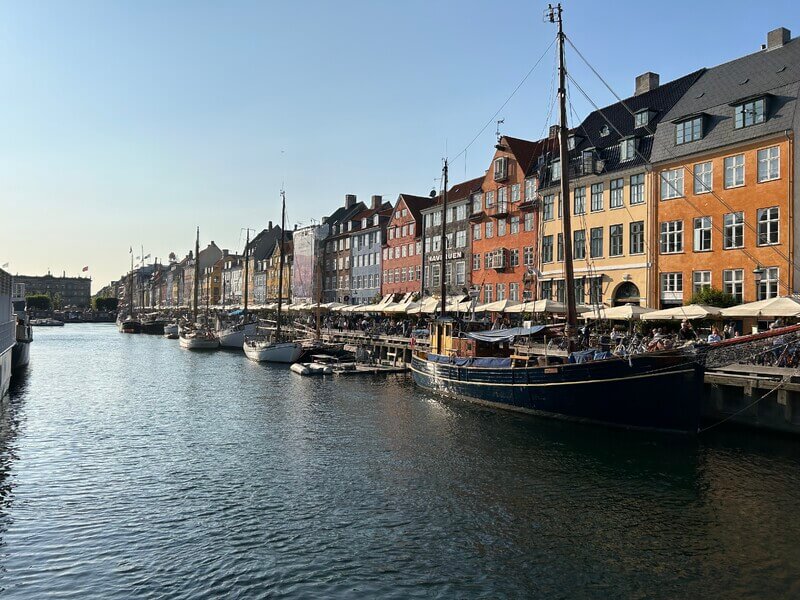Hello friends – or rather, hej venner – from Denmark!
I write to you amidst a full tourist’s agenda, squeezed loosely around a work trip to Copenhagen.
That’s right: over the past few days I’ve sampled smørrebrød between emails, crept around Freetown Christiania after conference hours and indulged in ice cream in Nyhavn (apple sorbet and whiskey flavour, no less).
Thanks to Tivoli’s late opening hours, I’ve also been on post-9pm rides of the ‘Dæmonen’ and the original ‘Roller Coaster’ – the latter built more than a hundred years ago, but still winning hearts and minds, young and old, in the digital age.
This morning the thrill rides continue with a seaside gallop on the beach. What can I say: I found an equestrian centre next to the airport and couldn’t resist.
“Just a minute,” I hear you ask.
“Didn’t you say this was a work trip?”
Work hard, play hard
Before panic and ‘FOMO’ set in, bear in mind that in addition to the aforementioned activities, I have managed some traditional “busy-ing” too.
The ‘done’ list for the last forty-eight hours includes attending a two-day conference, travelling to meet reinsurance buyers at their offices, explaining Supercede to a swathe of Northern European insurance company representatives, and organising a trip to Zurich and Munich for later in the month (let me know if you’ll also be there!).
On top of all that – stoically accompanied by Danish superstars Carl Nielsen, Niels Gade and Dizzy Mizz Lizzy, to the chagrin of my neighbours – yesterday’s late evening was spent preparing this latest piece in a series of eclectic ‘thought leadership’ articles for reinsurance enthusiasts the world around.
And if, regular readers, you’re experiencing some angst that we haven’t tucked into the usual reinsurance chat just yet, don’t worry: the all-important filling of the Danish pastry is very much on its way.
So begins the classic story arc for which this author claims some small, GPT-free, non-critical acclaim: first, wrapping the innocent reader in inviting and evocative-if-not-over-complicated prose; then, gradually unveiling an elaborate-and-extremely-niche analogy, seemingly unrelated to reinsurance; and then, finally, ensuring they succumb to the perfectly logical conclusion that they should probably sign up to a certain reinsurance platform, if they haven’t already (ahem).
Nay, not today!
But I suspect you’re already familiar with that narrative by now, so let’s mix it up a bit (sort of).
Especially if a Supercede subscription is already working its way through your procurement department (and if it isn’t: what – other than lots of manual data work – have you been doing all this time?!).
Today, let’s talk about something a bit different instead.
Something mutually interesting.
Literally.
Let’s talk about mutual insurance companies and in particular, their reinsurance needs: including the conundrums created for capital, when your policyholders are your shareholders.
But first, we’d be remiss not to remind ourselves of the reinsurance headaches shared by mutual and non-mutual insurers alike.
Northern lights, late nights
Long days aren’t just a feature of the Danish summer: for ceded re teams doing battle with disparate data sources, it's long days and long delays all year round.
I’ve had the joy of meeting many reinsurance buyers over the past few years, and the complaints have been almost universally consistent.
Not complaints about me, to be clear; but rather, about the buying process.
Normally, sat near the top of the list is the challenge of bringing data together from disparate entities, lines of business and regions consistently: almost never is it in the same starting format; rarely is it derived from the same set of legacy systems; and almost always, it brings with it the promise of months of back and forth over questions that lead only to vague answers.
The unenviable task of creating a harmonious view of these underlying portfolios falls usually to a central ceded re team; and if it doesn’t, it’s probably because the task of trying to coordinate it at all has remained, frankly, too intimidating.
But in today’s market, the potential leverage, oversight and analytical insight that comes with a single, unified view of your group’s collective underwriting portfolio could be vital to success, or even survival.
And at mutual insurance companies, where the fortunes of policyholder and shareholder are closely entwined, survival is somewhat top of mind.
Mutuality means frugality
It’s not just the classic operational pressures that keep teams up at night, when it comes to buying reinsurance for mutual insurers.
Due to their capital structure, mutuals face a genuine challenge when it comes to protecting their balance sheet, and that makes reinsurance especially important.
Don’t just take my word for it:
Mutual insurers generally face higher costs of raising new capital than stock insurers.
The above opening to the abstract for ‘Capital Structure Decisions in the Insurance Industry: Stocks versus Mutuals’, by insurance boffins Harrington and Niehaus, explains why mutual insurers are typically required to keep a closer eye on solvency than their stock insurer counterparts.
Their capital structure is not nimble, by default. And whilst a mutual company’s policyholder surplus can normally stretch to cover both the cost of primary losses and the cost of reinsurance purchases, what happens when – almost overnight – it doesn’t?
Insurer-owned reinsurers
Couldn’t we just stick together the insurers into a sort of mutual reinsurer?
Short answer, yes.
The concept that may one day be coined the ‘meta-mutual’, ‘re-mutual’ or ‘exponen-tual’ does already exist, and in the United States alone, it's been around and in action for more a century.
The eponymous hero of the story, Mutual Re, was formed off the back of a NAMIC conference in 1917: initially funded from the policyholder surpluses of sixteen different mutual insurers, it was able to start writing business in 1921, with a capital base of around $1.5m.
Mutual Re is still going strong today, with five member insurers collectively committing more than $5bn of policyholder surplus.
But next to the capital available in the reinsurance market more generally – and the demand for reinsurance generated by mutual insurers worldwide – mutual reinsurance remains a drop in a much larger capital ocean.
That means, for most mutuals, an at-least annual trip to the general reinsurance market is unavoidable, to ensure the protection they need can be procured.
And that – amidst some of the toughest market conditions in recent memory – comes at an ever higher price tag.
Goodbye, good buy
Is there anything mutuals can do to balance the playing field back in their favour?
I promised I wouldn’t follow my usual story arc in this discussion, so I’ll let you read my tips on getting the best reinsurance pricing from a prior article instead.
In the meantime, I'll conclude this one with a favourite of The Reinsurance Podcast: the art of (re)insurance analogy.
Perhaps the reason I’ve been itching to write about mutuals this week is my current location: when you think about it, Denmark itself is a bit like a mutual insurance company.
It’s old, reliable and stable – an independent country since the 10th century – and though its resources are spread across more than a thousand islands (much like the shareholder-policyholders of a mutual) it is a rich country, with one of the highest standards of living – and the lowest level of corruption – in the world.
What’s more, the Danes have maintained this poise and status through centuries of shrewd investment into the best available technology and transport infrastructure: from the superior Viking longboats of old; to the Copenhagen of today’s lightning fast metro, exceptionally clean canals and rivers, uniformly electric taxis and extensive cycle networks for sharing-economy bicycles.
Mutual insurers who continuously invest in their future as Denmark has – and make the wise choice to adopt the latest and greatest in reinsurance technology – will no doubt likewise see their success and longevity endure.


